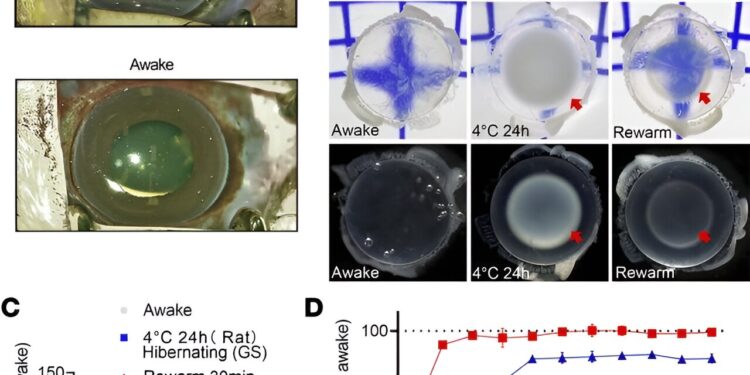GS lens opacity is reversed during the hypothermia-rewarming cycle. Credit: Clinical Research Journal (2024). DOI: 10.1172/JCI169666
Researchers at the National Institutes of Health (NIH) and their collaborators have identified a protein, known as RNF114, that reverses cataracts, a clouding of the lens of the eye that commonly occurs in older adults. The study, which was conducted in 13-lined ground squirrels and rats, may represent a possible nonsurgical strategy for managing cataracts, a common cause of vision loss. The study, published in the Clinical Research Journal.
“Scientists have long sought an alternative to cataract surgery that is effective, but not without risk. Lack of access to cataract surgery is a barrier to care in some parts of the world, making untreated cataracts a leading cause of blindness worldwide,” said Dr. Xingchao Shentu, a cataract surgeon and co-principal investigator from Zhejiang University, China.
This new discovery is part of ongoing research at the NIH’s National Eye Institute (NEI) on a hibernating mammal, the 13-lined ground squirrel. In these ground squirrels, the light-sensitive photoreceptor cells in the retina are primarily cones, making the ground squirrel useful for studying cone-related properties, such as color vision. In addition, the ground squirrel’s ability to withstand months of cold and metabolic stress during hibernation makes it a model for vision scientists to study a range of eye diseases.
The researchers found that during hibernation, the ground squirrels’ lenses became cloudy at about 4 degrees Celsius, but quickly became clear after warming. In comparison, non-hibernators (the rats in this study) developed cataracts at low temperatures, but these did not disappear with warming.
Cataract formation in hibernating animals exposed to low temperatures is likely a cellular response to cold stress and is one of many changes their bodies undergo as their tissues adapt to freezing temperatures and metabolic stress. Humans do not develop cataracts when exposed to low temperatures.
“Understanding the molecular factors behind this reversible cataract phenomenon could point us toward a potential treatment strategy,” said study co-principal investigator Wei Li, Ph.D., a senior scientist in the NEI’s Retinal Neurophysiology Section.
The primary function of the lens is to focus light on the retina at the back of the eye. As we age, cataracts form when proteins in the lens begin to fold incorrectly and form clumps that block, scatter, and distort light as it passes through the lens. For reasons that are unclear, aging can disrupt protein homeostasis, a process that maintains the balance of newly produced proteins and the turnover of old proteins.
To study reversible cataracts in ground squirrels at the molecular level, the team developed a laboratory model using stem cells engineered from ground squirrel cells by the NEI’s Li lab. Using this platform, the researchers focused on part of a vast network that maintains protein homeostasis in part by breaking down old proteins, known as the ubiquitin-proteasome system.
Specifically, RNF114 was significantly increased during warming in ground squirrels, compared to non-hibernating rats. RNF114 has previously been shown to help identify old proteins and facilitate their degradation.
To further study the effect of RNF114, they again used a non-hibernating cataract model (rat) by incubating its lenses at 4 degrees Celsius. Normally, such cataracts do not resolve with warming. However, when the lenses were pretreated with RNF114, the cataracts quickly resolved after warming.
The team said the findings provide evidence that it is possible to induce cataract healing in animals. In future studies, the process will need to be refined so that scientists can stimulate the degradation of specific proteins to see how to precisely regulate protein stability and turnover. This mechanism is also an important factor in many neurodegenerative diseases, they said.
More information:
Hao Yang et al, Reversible cold-induced lens opacity in a hibernator reveals a molecular target for cataract treatment, Clinical Research Journal (2024). DOI: 10.1172/JCI169666
Provided by the National Institutes of Health
Quote:Ground squirrel study points to potential development of cataract drug (2024, September 18) retrieved September 18, 2024 from
This document is subject to copyright. Apart from any fair dealing for the purpose of private study or research, no part may be reproduced without written permission. The content is provided for informational purposes only.



